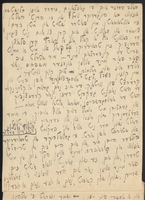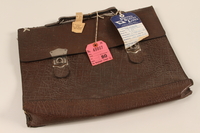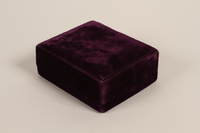Overview
- Brief Narrative
- Luftwaffe M1935 combat helmet like those used by German paratroopers circa 1939. The origins and use of this helmet are not known. It was acquired by Nina Merrick many years after the war in the United States. Nina was originally from Rotkitno, Poland, where she lived with her parents Yeshua and Masha, and siblings Yitzthak and Chana. Rokitno was occupied by the Soviet Union in September 1939. After Germany invaded the Soviet Union in June 1941, Nina's mother was arrested and hanged. Nina and her family were moved to Berisov ghetto (Barysau, Belarus.) In August 1942, Nina escaped to the forest during an SS raid. Shortly after this, the ghetto was surrounded and the inhabitants murdered by German SS and local Ukrainians. While hiding, Nina encountered an uncle and two cousins. They joined the Kopvak partisan group and Nina learned to be a nurse. In February 1943, the partisan commander Kopvak sent Nina to technical school in Moscow, where she remained until the war ended in May 1945. She went to Poland to search for survivors, but found none. Nina then went to Eschwege displaced persons camp in Germany. In February 1947, she for America to join her maternal aunt.
- Date
-
manufacture:
1939
- Geography
-
found:
Columbia (Md.)
manufacture: Berlin (Germany)
- Credit Line
- United States Holocaust Memorial Museum Collection, Gift of the Leon and Nina S. Merrick family
- Markings
- interior, underside of metal band, left side, engraved : B & C / BERL[IN] / 1939 [Biedermann u. Czarnikow]
interior, underside of metal band, right side, engraved : 64nA56
interior, back apron, engraved, white paint : [4]286
interior, right apron, engraved : 6E64
interior, split rivets, engraved : A39 / A39 / A39 - Contributor
-
Subject:
Nina S. Merrick
Manufacturer: Biedermann u. Czarnikow
Issuer: Germany. Luftwaffe
- Biography
-
Nechama Szuster (later Nina Merrick)) was born in Rokitno, Poland, (Rokytne, Ukraine) on May 18, 1929, to Yeshua and Masha Bryk Szuster. Her father was a builder, mostly of ovens, but also houses. Nechama had two older siblings, a brother Yitzchak and a sister Chana. The family was orthodox and somewhat observant, but her father was especially devout. The family was divided politically divided. Her brother was an ardent Zionist, and her sister belonged to Dror, a Zionist organization, and her mother was communist. Nechama belonged to HaShomer Hatzair and attended Beth Sefer Tarbut, a private Hebrew school. Her sister attended the Polish school. They did not associate with many Polish people as most were very antisemitic. But the Jewish community was very closeknit and Nechama had a happy childhood.
In September 1939, Germany invaded Poland from the west and the Soviet Union invaded from the east Rokitno was occupied by the Soviet Union. Her mother spoke Russian and was one of those chosen to teach the Russian constitution. The Hebrew school was closed. It reopened as a Yiddish school. Nechama’s mother did not want her to study Yiddish, so Nechama was enrolled in the Ukrainian school. In June 1941, Germany invaded the Soviet Union. A pro-German Ukrainian group took over the government of the town. But it was a time of chaos and uncertainty as control of the village seemed to switch from one armed faction to another. Soon, SS personnel arrived and harsh anti-Jewish measures were enacted. Nechama and her family fled to a small village, Glinne, where most of her father's family lived. The first time she saw German soldiers was when they arrived with Polish police to arrest her mother. Her mother had been a delegate for the Soviet government, traveling to different districts and serving in court. Now Masha was targeted by Polish residents and taken away. A while later, they learned that all the Jewish residents of a nearby village had been killed by their Ukrainian neighbors. A few days later, a Ukrainian delegation arrived from that village to ask the Jews in Glinne to take the corpses away and bury them. Nechama’s maternal uncle Necham Bryk arranged the transport and burial. Soon after this, German troops arrived and Nechama and her family were forcibly relocated to a few Jewish houses surrounded by barbed wire in Berisov (Barysau, Belarus.) They had to wear yellow patches that said Jude on the front and back of their clothes. All residents were required to do forced labor. Nechama and her sister Chana peeled potatoes for German soldiers. Her father and brother worked outside the ghetto for Ukrainians. One night in August/September 1942, they were awakened by barking dogs and shouting. The SS raided their home. Her maternal uncle, who was head of the ghetto was shot, along with his young son. Nechama ran to the room where her father was praying. Soldiers were there, waiting for him to finish, and one of them grabbed Nina and said he was going to kill her. In the chaos, she managed to pull free and jump out of a window. She ran off and hid in the woods.
In the morning, Nechama encountered her paternal uncle Josef Szuster. They survived for weeks by begging from the Ukrainians, although it was risky. The Germans promised a pound of salt to anyone who turned in a Jew. Necham went to the home of a man who had worked for her father. He yelled out to alert the Germans, but she escaped. At another farm, the Ukrainian farmer was very kind, asked about their family, and told them that Josek’s two daughters were hiding in his haystacks. After a few months, they found and joined the Ukrainian partisans. The group commander, Sydor Artemovych Kovpak, a World War I hero, with one of the oldest and most effective partisan fighting units, was sympathetic to 13 year old Nechama, the only surviving member of her family. He told her he would watch over her as if she were his daughter. Nechama was taught to be a nurse, and to wash wounded fighters and hold them down during operations.
In February 1943, the unit was ordered to join a Soviet offensive in the Carpathians and Kovpak sent Nechama to Moscow to keep her safe and to attend technical school. She worked in a factory and attended school. She was in Moscow until after the end of the war in May 1945. She then was given a trip to Poland to search for relatives. This was when she learned that her mother had been hanged after being arrested in 1941. Her father, sister and brother were killed around the time of the raid during which Nechama escaped. The village had been surrounded by German SS and local Ukrainian auxiliaries, who destroyed the ghetto and its inhabitants. Her entire extended family perished during the war. Instead of returning to Moscow, Nechama went to Eschwege displaced persons camp in Germany. She later lived on a Jewish collective farm. In 1947, Nechama was contacted by a maternal aunt in Washington DC, who wanted to bring her to America. On February 7, Nechama left from Bremen on the Ernie Pyle, arriving in New York on February 18. She resumed the schooling. Nina met Lajb Kusmirek, later Leon Merrick, at a party at her aunt’s one night. He was born Zgierz, Poland, in 1926. After the German invasion, he and his family left for Łódź, and lived in the ghetto from 1940 until its liquidation in 1944. Lajb survived slave labor camps, Kielce, and Czestochowa, and after being sent to Germany in December 1944, Buchenwald and Flossenbürg concentration camp. He was liberated during a death march by US troops on April 23, 1945. Leon emigrated to the US in 1949 and was drafted into the US Army in 1952. Leon and Nina married in 1952 and had two daughters. Nina and Leon have shared their experiences with numerous groups and volunteered for many years at the United States Holocaust Memorial Museum.
Physical Details
- Classification
-
Dress Accessories
- Category
-
Headgear
- Object Type
-
Helmets (lcsh)
- Physical Description
- Dark gray painted, domed, pressed molybdenum steel helmet with a rolled rim, short front visor, and flared neck apron, with a ventilation rivet on each side. Near the bottom edge are 3 rivets to attach the interior liner band, a 1st pattern, aluminum alloy, M1931 style band. The leather liner is missing. The dark brown leather, right chin strap is looped by D rings to metal strips on the liner band. It has a single prong buckle; the left strap has broken off. There is a lacquered ink decal on each side: a 2nd pattern, black and white Luftwaffe eagle, diving with outstretched wings, on the right and a shield with the German national colors: black, white, and red, on the left.
- Dimensions
- overall: Height: 11.250 inches (28.575 cm) | Width: 6.500 inches (16.51 cm) | Depth: 9.000 inches (22.86 cm)
- Materials
- overall : steel, aluminum alloy, paint, leather, metal
Rights & Restrictions
- Conditions on Access
- No restrictions on access
- Conditions on Use
- No restrictions on use
Keywords & Subjects
Administrative Notes
- Legal Status
- Permanent Collection
- Provenance
- The helmet was donated to the United States Holocaust Memorial Museum in 1988 by Nina Schuster Merrick.
- Funding Note
- The cataloging of this artifact has been supported by a grant from the Conference on Jewish Material Claims Against Germany.
- Record last modified:
- 2022-07-28 18:28:37
- This page:
- https://collections.ushmm.org/search/catalog/irn514703
Download & Licensing
In-Person Research
- By Appointment
- Request 21 Days in Advance of Visit
- Plan a Research Visit
- Request to See This Object
Contact Us
Also in Nina S. Merrick collection
The collection consists of a briefcase, Luftwaffe helmet, medal, and diary relating to the experiences of Nechama Szuster (Nina Schuster) after the Holocaust in a displaced persons camp in Eschwege, Germany, and following her emigration to the United States.
Date: approximately 1939-approximately 1945

Nina Merrick papers
Document
The Nina Merrick papers consist of biographical materials, a diary, correspondence, photographs, and printed materials documenting Nina Merrick from Rokitno, Poland, her escape from the Borisov ghetto, postwar life at the Eschwege displaced persons camp, immigration to the United States, and American acculturation. Biographical materials include Merrick’s diary, an UNRRA meal ticket for transients, an embarkation card for Merrick’s immigration, and a school essay about her first impressions of the United States. The diary consists of eight hand‐stitched pages in Yiddish recounting her escape from the Borisov ghetto in 1942. She wrote the diary in 1945 at the displaced persons camp in Eschwege, Germany. Correspondence includes a 1946 telegram about Merrick’s efforts to immigrate to the United States and a 1949 letter about Merrick’s award‐winning essay on immigrants. Photographs depict the SS Ernie Pyle, a school bazaar, piles of corpses presumably at a concentration camp, Nina at a children’s house in Feldbach, a young man named Shemon in Cyprus, a group of young people at the Eschwege displaced persons camp, and a children’s procession in Eschwege. Printed materials include a copy of Merrick’s high school’s literary magazine, The Review, including a copy of her award‐winning essay “The Contributions of Our Immigrants,” and three clippings about children immigrating to the United States, Merrick, and her American education.

Brown leather briefcase acquired by a Polish Jewish woman in a DP camp
Object
Leather briefcase used by 17 year old Nechama (Nina) Szuster to carry her important documents after the war. It was acquired with the assistance of the United Nations Relief and Rehabilitation Administration (UNRRA). Nina was originally from Rotkitno, Poland, where she lived with her parents Yeshua and Masha, and siblings Yitzthak and Chana. Rokitno was occupied by the Soviet Union in September 1939. After Germany invaded the Soviet Union in June 1941, Nina's mother was arrested and hanged. Nina and her family were moved to Berisov ghetto (Barysau, Belarus.) In August 1942, Nina escaped to the forest during an SS raid. Shortly after this, the ghetto was surrounded and the inhabitants murdered by German SS and local Ukrainians. While hiding, Nina encountered an uncle and two cousins. They joined the Kopvak partisan group and Nina learned to be a nurse. In February 1943, the partisan commander Kopvak sent Nina to technical school in Moscow, where she remained until the war ended in May 1945. She went to Poland to search for survivors, but found none. Nina then went to Eschwege displaced persons camp in Germany. In February 1947, she left for America to join her maternal aunt.

National Society of Colonial Daughters essay award with case won by a Polish Jewish refugee
Object
Medal and presentation case awarded in 1949 to twenty year old Nina Schuster by the National Society of Colonial Daughters "for a patriotic essay of superior merit, titled "The Contribution of Our Immigrants." Nina was originally from Rotkitno, Poland, where she lived with her parents Yeshua and Masha, and siblings Yitzthak and Chana. Rokitno was occupied by the Soviet Union in September 1939. After Germany invaded the Soviet Union in June 1941, Nina's mother was arrested and hanged. Nina and her family were moved to Berisov ghetto (Barysau, Belarus.) In August 1942, Nina escaped to the forest during an SS raid. Shortly after this, the ghetto was surrounded and the inhabitants murdered by German SS and local Ukrainians. While hiding, Nina encountered an uncle and two cousins. They joined the Kopvak partisan group and Nina learned to be a nurse. In February 1943, the partisan commander Kopvak sent Nina to technical school in Moscow, where she remained until the war ended in May 1945. She went to Poland to search for survivors, but found none. Nina then went to Eschwege displaced persons camp in Germany. In February 1947, she left for America to join her maternal aunt.



